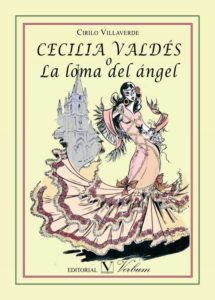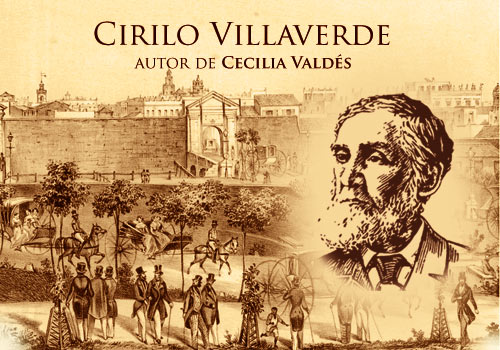 LA HISTORIA DE CECILIA VALDES, UNA INTERACCIÓN DE CLASES Y RAZAS EN CUBA.
LA HISTORIA DE CECILIA VALDES, UNA INTERACCIÓN DE CLASES Y RAZAS EN CUBA.
Cecilia Valdés es una novela del escritor cubano Cirilo Villaverde (1812-1894) y una zarzuela basada en la novela. Es una obra importante por su calidad y su revelación de la interacción de clases y razas en La Habana, Cuba.
La primera versión de la novela Cecilia Valdés o la Loma del Angel se publicó en La Habana en 1839. Después de varias revisiones, la versión definitiva y extendida se publicó en la ciudad de Nueva York en 1882. Nunca se ha agotado en español, y traducido a varias ediciones en inglés (como Cecilia Valdés “o” Angel Hill). Es ampliamente considerada como la mejor novela cubana del siglo XIX.
¿CÓMO FUE CECILIA VALDÉS?
Su tipo era el de las vírgenes de los pintores más famosos. Debido a una frente alta, coronada con cabello negro y abundante, ondulaba naturalmente, unía rasgos muy regulares, nariz recta que comenzaba desde las cejas, y eso para mantenerse algo corto y elevado, si no es el labio superior, como para ver dos dientes pequeños y blancos Sus cejas describieron un arco y dieron mayor sombra a los ojos negros y desgarrados, que eran todo movilidad y fuego. La boca tenía una niña y labios carnosos, lo que indicaba más voluptuosidad que la firmeza de carácter. Las mejillas llenas y redondas y un hoyuelo en el centro de la barba formaban un hermoso conjunto, que para ser perfecto solo necesitaba que la expresión fuera menos maliciosa, si no maligna ”.
Así es como el escritor cubano Cirilo Villaverde describe a Cecilia Valdés en su novela homónima, y creo que esta debe haber sido la realidad o la imaginación del escritor, tal vez se inspiró en un modelo que vio en las calles de La Habana colonial, donde El tipo cubano se puede encontrar en cualquier plaza, callejón o con vista a un balcón.
¿CÓMO ES LA HISTORIA DE CECILIA VALDES?
La historia tiene lugar en la Cuba colonial alrededor de 1830. La joven y bella mulata de piel clara, Cecilia Valdés, es la hija ilegítima del poderoso magnate de la tierra y comerciante de esclavos, Cándido de Gamboa. Leonardo de Gamboa es su hijo legítimo. Leonardo se enamora de Cecilia, sin darse cuenta de que ella es su propia media hermana, y se convierten en amantes. Al mismo tiempo, un pobre músico negro, José Dolores Pimienta, también está irremediablemente enamorado de Cecilia. Cecilia rechaza los avances de Pimenta y concibe al hijo de Leonardo.
Sin embargo, el amor entre Leonardo y Cecilia no dura. Él la abandona y se compromete con una mujer blanca de clase alta, Isabel Ilincheta. Cecilia recurre a la fiel Pimienta para planear venganza. El día de su boda, Leonardo es asesinado en los escalones de la catedral por Pimienta que actúa por instigación de Cecilia. Pimienta es ejecutada y ella es encarcelada.
Cecilia Valdés revela los intrincados problemas de las relaciones raciales en Cuba. Existen los círculos sociales de élite de los blancos criollos y nacidos en España; el creciente número de mulatos, de los cuales Cecilia es uno, y los negros: algunos esclavos, algunos libertos. Los negros también se dividen entre los que nacieron en África y los que nacieron en Cuba, los que trabajaban en la plantación de azúcar y los que trabajaban en los hogares de los ricos en La Habana. Cecilia Valdés es un lienzo que muestra la interacción sexual, social y racial de los cubanos de la época.
CECILIA (Producción de la película de 1982)
Una película basada en la novela fue producida en Cuba en 1982. La película está protagonizada por Daisy Granados como Cecilia Valdés e Imanol Arias como Leonardo de Gamboa.
 CECILIA VALDES STORY, AN INTERACTION OF CLASSES AND RACES IN THE CUBAN HISTORY.
CECILIA VALDES STORY, AN INTERACTION OF CLASSES AND RACES IN THE CUBAN HISTORY.
Cecilia Valdés is both a novel by the Cuban writer Cirilo Villaverde (1812–1894) and a zarzuela based on the novel. It is a work of importance for its quality, and its revelation of the interaction of classes and races in Havana, Cuba.
The first version of the novel Cecilia Valdés o la Loma del Angel was published in Havana in 1839. After several revisions, the definitive and extended version was published in New York City in 1882. It has never been out of print in Spanish, and have been translated into several English editions (as Cecilia Valdes” or “Angel Hill). It is widely regarded as the best Cuban novel of the 19th century.
HOW WAS CECILIA VALDÉS?.
Her type was that of the virgins of the most famous painters. Because to a high forehead, crowned with black and copious hair, naturally waved, she joined very regular features, straight nose that started from the eyebrows, and that for staying something short raised one if it is not the upper lip, as if to see two small and white teeth Her eyebrows described an arch and gave greater shadow to the black and torn eyes, which were all mobility and fire. The mouth had a girl and full lips, indicating more voluptuousness than the firmness of character. The full and round cheeks and a dimple in the middle of the beard formed a beautiful set, which to be perfect only needed the expression to be less malicious, if not malignant ”.
This is how the Cuban writer Cirilo Villaverde describes Cecilia Valdés in his homonymous novel, and I think that this must have been the reality or imagination of the writer, perhaps he was inspired by a model he saw in the streets of colonial Havana, where that Cuban type can be found in any square, alley or overlooking a balcony.
HOW IS THE STORY OF CECILIA VALDES?
The story takes place in colonial Cuba around 1830. The young and beautiful light-skinned mulatta, Cecilia Valdés, is the illegitimate daughter of powerful land magnate and slave trader, Cándido de Gamboa. Leonardo de Gamboa is his legitimate son. Leonardo falls in love with Cecilia, not realizing that she is his own half-sister, and they become lovers. At the same time, a poor black musician, José Dolores Pimienta, is also hopelessly in love with Cecilia. Cecilia rejects Pimenta’s advances and conceives Leonardo’s son.
However, the love between Leonardo and Cecilia does not last. He abandons her and becomes betrothed to a white upper-class woman, Isabel Ilincheta. Cecilia turns to the faithful Pimienta to plan revenge. On the day of his wedding, Leonardo is assassinated on the steps of the cathedral by Pimienta who acts on the instigation of Cecilia. Pimienta is executed, and she is thrown in prison.
Cecilia Valdés reveals the intricate problems of race relations in Cuba. There are the elite social circles of Spanish-born and creole whites; the growing number of mulattos, of which Cecilia is one, and the blacks: some slaves, some freedmen. The blacks are also divided between those who were born in Africa and those who were born in Cuba, those who worked on the sugar plantation and those who worked in the households of the wealthy in Havana. Cecilia Valdés is a canvas displaying the sexual, social, and racial interaction of the Cubans of the day.
Cecilia (1982 film)
A film based on the novel was produced in Cuba in 1982. The film stars Daisy Granados as Cecilia Valdés and Imanol Arias as Leonardo de Gamboa.
Agencies/ Radio Encyclop./ Juan B. Rodriguez/ Wiki/ Internet Photos/ YouTube/ Arnoldo Varona/ www.TheCubanHistory.com
THE CUBAN HISTORY, HOLLYWOOD.



 < CECILIA VALDÉS Story, an Interaction of Classes and Races in Cuban History. VIDEOS.
< CECILIA VALDÉS Story, an Interaction of Classes and Races in Cuban History. VIDEOS.



